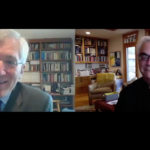It’s impossible to spend a Saturday night in Death Valley, the football stadium at Louisiana State University, without hearing Mel McDaniel’s “Louisiana Saturday Night” playing over the public address system and the crowd of nearly one hundred thousand singing along with pride:
Waiting in the front yard sitting on a log,
Single-shot rifle and a one-eyed dog,
Yonder come the kinfolk, in the moonlight,
Louisiana Saturday night.
Ironically, the droves of Louisiana natives chanting the Cajun anthem are not sitting outside their homes awaiting visitors, and it’s a safe bet few ever have. La veille, the long-held tradition described in the song, has been replaced by Top Golf, Rock ’n’ Bowl, Painting and Pinot, and many other modern businesses that cater to the desire to gather.
When my great-grandmother Cecile was a girl, her family would convene on their wide, Acadian-style front porch after supper each night to visit until bedtime. Often, neighbors stopped by, uninvited but always welcome, and shared stories or joined in a song or two. Much like Americans in our current situation, Cajuns, the descendants of some three thousand French colonists exiled from Nova Scotia by the British in 1755, were financially suffering and geographically isolated for the first two centuries of their relocation in Louisiana. But they craved community no less. Until the mid-1900s, this custom of visiting neighbors at night, called la veille (“vigil” in Parisian French), was the typical mode of mingling for rural Cajuns without means.
Start your day with Public Discourse
Sign up and get our daily essays sent straight to your inbox.Empty Rocking Chairs on Empty Porches
Today, though porches and rocking chairs are still in vogue in south Louisiana décor, they mostly collect dust. In 1921 the state government forbade the use of French in public schools, stigmatizing Cajun heritage along with its tongue. By mid-century, advances in technology and increased income enabled widespread ownership of radios, televisions, and air conditioning. While the latter enticed farming families indoors in sweltering Louisiana summers, the tube offered novel, after-dinner entertainment year-round—and a path to cultural and linguistic assimilation. Economist Joe Cortright’s 2015 report Less in Common observes that the average amount of time Americans spend watching television has nearly doubled since 1965 and now accounts for over half of all American leisure time, according to the U.S. Bureau of Labor Statistics.
At the same time, increased mobility and rising personal incomes gave birth to a $341.4 billion arts, entertainment, and recreation industry, providing commercial venues for social connection. In fact, a week before COVID-19 closures began, I passed a Friday night with friends hurling axes at wooden bullseyes—not at a farm or a “camp,” as fishing houses on the bayou are colloquially called, but in a hip new establishment in Mid-City Baton Rouge. My great-grandfather, who actually used axes on his farm in the Great Depression Era, would be perplexed at such innovative entertainment.
Together, TV and entertainment enterprises have hollowed out neighborhood streets—and the communities they once supported. And not just in rural or suburban America: my siblings living in downtown Dallas and Princeton do not socialize with their nearest neighbors either. More than a third of Americans today never interact with neighbors, a figure that Cortright found has steadily climbed over the past four decades. The locus of community has shifted away from residential spaces to commercial city-centers. Evenings find most of us privately binging on Netflix at home—or commuting to venues like Civil Axe Throwing for manufactured fellowship.
COVID-19: A Reveille for la Veille
Stay-at-home orders have begun to fill front yards again. As COVID-19 spread rapidly in Louisiana in mid-March, I began working from my family home alongside my mom, our days broken up only by Zoom dates with grandmothers and out-of-town siblings. We began to feel the absence of the commercial city-center, the isolation of our new normal. It seemed virtual connection was the only one possible, and it simply didn’t satisfy. In outsourcing our social interactions, have we forgotten that we are capable of creating them on our own?
Feverishly seeking a change in scenery after our first week at home, my mom and I went for an afternoon stroll. Halfway down our suburban street, we heard an old familiar voice call out, “Long time, no see!” Though Miss Leanne lives two doors down, it’s possible we haven’t had a conversation in two or more years. We paused our afternoon excursion and traded updates: a child recently moved out-of-state to start his first job; a grandchild is already in college (and just yesterday she was in diapers!); a family on the other side of the street is fighting cancer.
A few days later, Miss Leanne sent out an email: “Neighborhood Happy Hour at 6:00 P.M. Bring a chair and your favorite beverage. See y’all on the street!”
So, my family scrounged together lawn chairs and libations and headed down the driveway with a yardstick that Saturday night. In household clusters a couple of yards apart, we traded news stories and work-from-home escapades, work-out woes and grocery trip tips, wistful plans for upcoming vacations that might never be, and updates on home improvement projects suddenly under way. As daylight dwindled, I walked home renewed by a sense of community. La veille was making a comeback.
Since our reunion, I’ve seen signs of other neighborhoods reconnecting. A few mornings later, I drove past six empty chairs in a wide hexagon on a front lawn. Running around the LSU lakes one evening, I spotted two women with dogs, a pronounced 10-foot buffer between them as they visited and, farther down the road, two teens in a driveway catching up from pitch-and-catch distance. Even in Princeton, where front porch swings are considerably less common, my sister has noticed folks visiting in front yards.
Back to the Front Porch
Though we may not return to concert venues or even coffee shops anytime soon, it doesn’t mean we can’t connect offline. No matter the living situation, we can turn to a neighbor, the next person in earshot from a door or window, and find fellowship. In Atlanta, apartment-dwellers gather on balconies to cheer on healthcare workers at shift changes, and urban neighbors sing together from open windows each evening across the street in Rome.
As we accept the new normal—for however long this might last—maybe we can look to our past and reclaim our first communities, our neighborhoods, by reaching out to those nearest our quarantine bases. Hopefully we will find that, when we can finally resume life as we knew it, we will have more community, not less, richer connection, not poorer.
Lâche pas la patate!—a Cajun idiom taken as the unofficial motto of the cultural renaissance in Acadiana—means “Hold on to what’s important!” Let’s hold on to our neighborhoods and the traditions that sustain them this time around. Who knows? Maybe by football season we’ll sing “Louisiana Saturday Night” the right way, together from rocking chairs on our front porches.














